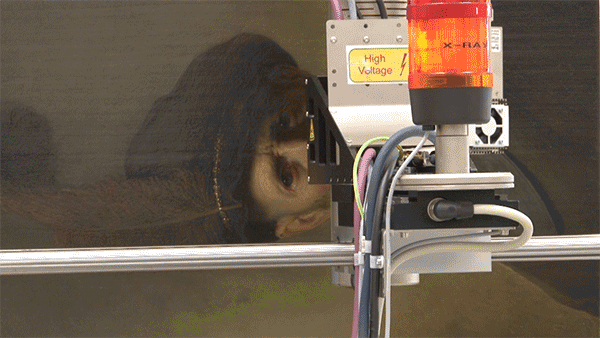Thanks to science, we now have a clearer image of the painting hidden beneath Rembrandt’s An Old Man in Military Costume. A paper published today in Applied Physics A reveals a color reconstruction of a painting of a young man that Rembrandt painted over centuries ago.
The presence of a hidden figure has been known since 1968, when the painting was first X-rayed. The color reconstruction was created by a team at the Getty Conservation Institute and the Getty Museum, together with collaborators from the University of Antwerp and the Delft University of Technology, using a technique known as macro-X-ray fluorescence scanning (macro-XRF or MA-XRF), which detects the chemical composition of an artwork without damaging it.
What they found:
- White is present in areas containing lead, used in Rembrandt’s time to make a creamy white paint.
- Red can be reconstructed where we find mercury, present in the scarlet pigment vermillion.
- Blues and greens are likely where we see copper, a component of pigments such as azurite and copper resinate.
- Earth tones from umber pigments are present in areas containing both iron and manganese.
Put together, this adds up to a man with brownish hair, with a collar (perhaps a metal gorget) and an olive cloak. (The line through the face is a shadow from the strong contour of the beret in the painting of the old man above.)

Tentative color reconstruction of the hidden portrait under An Old Man in Military Costume
In the view of curator Anne Woollett, it’s likely that the first painting is also by Rembrandt. It may even be another tronie (character study), like the image of the old man we see today, but one that Rembrandt based upon his own features. Rembrandt was known to have reused his supports (wood panels, canvases), painting over the initial composition with another, usually different image. About two dozen such “palimpsests” have been identified.
Among the Museum’s collection of Rembrandt paintings is another example: beneath Rembrandt Laughing lies a history scene. For the old masters, reusing expensive wood panels—in the case of the Old Man in Military Costume, a high-quality oak—would have made simple economic sense.
But why did Rembrandt abandon the initial figure, rotate the panel 180 degrees, and start again? “That’s the big question,” says Yvonne Szafran, head of paintings conservation at the Getty Museum. She is working with Anne, and scientist Karen Trentelman of the Getty Conservation Institute, to find the answer to this and many other unanswered questions about the painting. “Maybe he’s working something out in this first version, has an aha moment, then proceeds to execute the grander idea,” Yvonne suggested. “Or perhaps he simply started, put it aside, and returned to it later.”

X-radiographs of An Old Man in Military Costume. The X-ray at right is inverted to better show the hidden painting.
Art History Goes High-Tech
This project is an example of a major shift now taking place in art history, as technical imaging allows scholars to look at an artist’s work and technique in unprecedented detail. It’s also a leap forward for conservation science.
Just a few years ago, notes Karen, a study like this would have required transporting the fragile Old Man to the nearest synchrotron—in the Getty’s case, the one at Stanford—for a period of time. “As analytical tools become more portable and more affordable,” she says, “we can now bring the instrument to the painting, rather than the other way around.”

“What’s also exciting about the macro XRF scanner is that it produces scientific data as images, which are a universal language,” Karen told me. “I’ve never seen our curators as excited by data as they were on that day. I wasn’t showing them graphs with lines, I was showing them pictures.”
There is still much for the team to learn about Rembrandt’s Old Man. Up next is visualizing the figure’s clothing in better detail, and investigating how the colors in the final painting may have changed over time. “We think of Rembrandt’s colors as being rich but luminous,” said Yvonne, “but some of them have altered as they aged.”
Looking further ahead, the team hopes to eventually gain an even better view of the hidden painting, which is obscured by the thick pigment above. This is a time of many new and exciting developments in the analysis of artworks, paralleling the technological leaps being made across society, Yvonne told me. “As new and innovative equipment develops, it will be exciting to see what future investigations reveal.”
_______
“Rembrandt’s An Old Man in Military Costume: the underlying image reexamined” appears today in Applied Physics A. The paper’s authors are conservation scientist Karen Trentelman of the Getty Conservation Institute; curator Anne Woollett and conservator Yvonne Szafran of the J. Paul Getty Museum; cultural heritage scientists Koen Janssens and Geert van der Snickt of the University of Antwerp; and materials scientist Joris Dik of the Delft University of Technology.





It is amazing
Dio